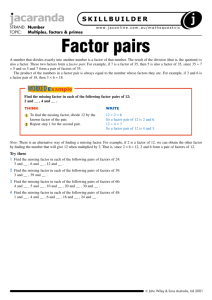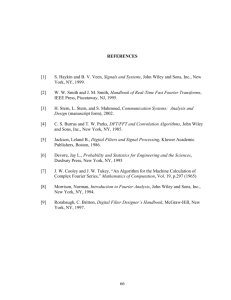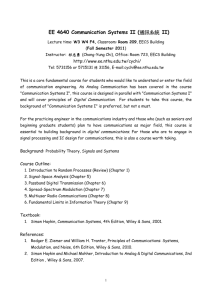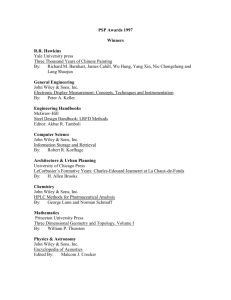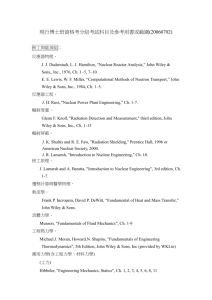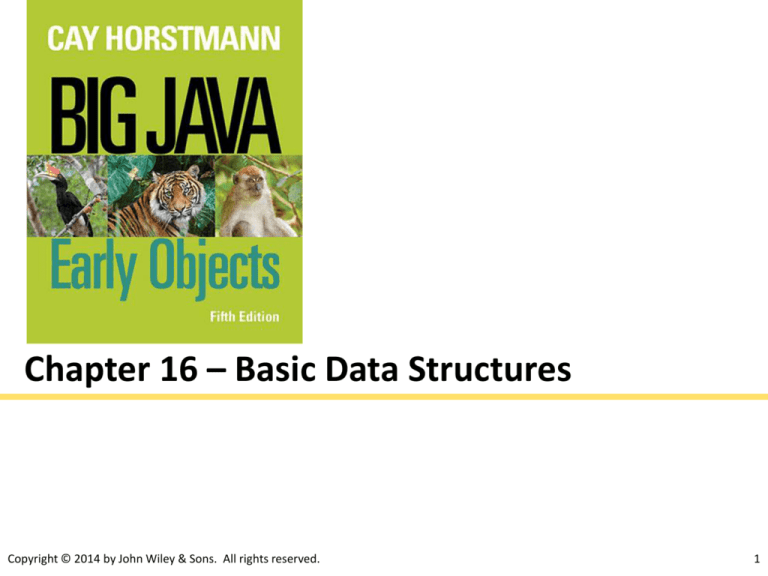
Chapter 16 – Basic Data Structures
Copyright © 2014 by John Wiley & Sons. All rights reserved.
1
Chapter Goals
To understand the implementation of linked lists and array
lists
To analyze the efficiency of fundamental operations of lists
and arrays
To implement the stack and queue data types
To implement a hash table and understand the efficiency of
its operations
Copyright © 2014 by John Wiley & Sons. All rights reserved.
2
Implementing Linked Lists - The Node Class
We will implement a simplified, singly-linked list.
A linked list stores elements in a sequence of nodes.
A Node object stores an element and a reference to the next
node.
• private inner class
• public instance variables
public class LinkedList
{
. . .
class Node
{
public Object data;
public Node next;
}
Copyright © 2014 by John Wiley & Sons. All rights reserved.
3
Implementing Linked Lists - The Node Class
A linked list object holds a reference to the first node:
• each node holds a reference to the next node.
public class LinkedList
{
private Node first;
public LinkedList() { first = null; }
}
public Object getFirst()
{
if (first == null) { throw new
NoSuchElementException(); }
return first.data;
}
Copyright © 2014 by John Wiley & Sons. All rights reserved.
4
Implementing Linked Lists - Adding and Removing the
First Element
When adding or removing the first element, the reference
to the first node must be updated.
public class LinkedList
{
. . .
public void addFirst(Object element)
{
Node newNode = new Node();
newNode.data = element;
newNode.next = first;
first = newNode;
}
. . .
}
Copyright © 2014 by John Wiley & Sons. All rights reserved.
5
Implementing Linked Lists – Adding the First Element
Figure 1 Adding a Node to the Head of a LinkedList
Copyright © 2014 by John Wiley & Sons. All rights reserved.
6
Implementing Linked Lists - Removing the First Element
The data of the first node are saved and later returned as
the method result.
The successor of the first node becomes the first node of
the shorter list.
The old node is eventually recycled by the garbage
collector.
public class LinkedList
{
. . .
public Object removeFirst()
{
if (first == null) { throw new NoSuchElementException(); }
Object element = first.data;
first = first.next;
return element;
}
. . .
}
Copyright © 2014 by John Wiley & Sons. All rights reserved.
7
Implementing Linked Lists – Removing the First Element
Figure 2 Removing the First Node from a LinkedList
Copyright © 2014 by John Wiley & Sons. All rights reserved.
8
The Iterator Class
Our simplified ListIterator interface has methods:
next, hasNext, remove, add, and set.
Our LinkedList class declares a private inner class
LinkedListIterator.
• LinkedListIterator implements our simplified ListIterator
interface.
• As an inner class LinkedListIterator has access to
o The instance variable first
o The private Node class.
A list iterator object has:
• A reference to the the currently visited node, position
• A reference to the last node before that, previous
• A isAfterNext flag to track when the next method has been
called.
Copyright © 2014 by John Wiley & Sons. All rights reserved.
9
The Iterator Class
The LinkedListIterator class:
public class LinkedList
{
. . .
public ListIterator listIterator()
{
return new LinkedListIterator();
}
class LinkedListIterator implements ListIterator
{
private Node position;
private Node previous;
private boolean isAfterNext;
public LinkedListIterator()
{
position = null;
previous = null;
isAfterNext = false;
}
. . .
}
}
Copyright © 2014 by John Wiley & Sons. All rights reserved.
10
Advancing an Iterator
To advance an iterator:
• Update the position
• Remember the old position for the remove method.
Copyright © 2014 by John Wiley & Sons. All rights reserved.
11
Advancing an Iterator
The next method:
class LinkedListIterator implements ListIterator
{
. . .
public Object next()
{
if (!hasNext()) { throw new NoSuchElementException(); }
previous = position; // Remember for remove
isAfterNext = true;
if (position == null)
{
position = first;
}
else
{
position = position.next;
}
return position.data;
}
}
. . .
Copyright © 2014 by John Wiley & Sons. All rights reserved.
12
Advancing an Iterator
The iterator is at the end if the list is empty (first == null) or if
there is no element after the current position (position.next ==
null).
The hasNext method:
class LinkedListIterator implements ListIterator
{
. . .
public boolean hasNext()
{
if (position == null)
{
return first != null;
}
else
{
return position.next != null;
}
}
. . .
}
Copyright © 2014 by John Wiley & Sons. All rights reserved.
13
Removing an Element
If this is the first element:
• Call removeFirst
• Otherwise, update the next reference of the previous node
Update isAfterNext to disallow another call to remove.
Copyright © 2014 by John Wiley & Sons. All rights reserved.
14
Removing an Element
The remove method:
class LinkedListIterator implements ListIterator
{
. . .
public void remove()
{
if (!isAfterNext) { throw new IllegalStateException(); }
if (position == first)
{
removeFirst();
}
else
{
previous.next = position.next;
}
position = previous;
isAfterNext = false;
}
. . .
}
Copyright © 2014 by John Wiley & Sons. All rights reserved.
15
Removing an Element
Figure 3 Removing a Node from the Middle of a Linked List
Copyright © 2014 by John Wiley & Sons. All rights reserved.
16
Adding an Element
After adding the new element
• set the isAfterNext flag to false to disallow a subsequent call to
the remove or set
Copyright © 2014 by John Wiley & Sons. All rights reserved.
17
Adding an Element
The add method:
class LinkedListIterator implements ListIterator
{
. . .
public void add(Object element)
{
if (position == null)
{
addFirst(element);
position = first;
}
else
{
Node newNode = new Node();
newNode.data = element;
newNode.next = position.next;
position.next = newNode;
position = newNode;
}
isAfterNext = false;
}
. . .
}
Copyright © 2014 by John Wiley & Sons. All rights reserved.
18
Adding an Element
Figure 4 Add a Node to the Middle of a Linked List
Copyright © 2014 by John Wiley & Sons. All rights reserved.
19
Setting an Element to a Different Value
set method changes the data in the previously visited
element.
Must follow a call to next.
The set method:
public void set(Object element)
{
if (!isAfterNext) { throw new IllegalStateException(); }
position.data = element;
}
Copyright © 2014 by John Wiley & Sons. All rights reserved.
20
Efficiency of Linked List Operations
To get the kth element of a linked list, you start at the
beginning of the list and advance the iterator k times
To get to the kth node of a linked list, one must skip over
the preceding nodes.
Copyright © 2014 by John Wiley & Sons. All rights reserved.
21
Efficiency of Linked List Operations
When adding or removing an element, we update a
couple of references in a constant number of steps.
Adding and removing an element at the iterator
position in a linked list takes O(1) time.
Copyright © 2014 by John Wiley & Sons. All rights reserved.
22
Efficiency of Linked List Operations
To add an element at the end of the list
• Must get to the end - an O(n) operation
• Add the element O(1) operation
Adding to the end of a linked list in our implementation
takes O(n) time
If the linked list keeps a reference to last as well as first
• The time is reduced to constant time: O(1)
We will conclude that adding to the end of a linked list
is O(1).
Copyright © 2014 by John Wiley & Sons. All rights reserved.
23
Efficiency of Linked List Operations
To remove an element from the end of the list:
• Need a reference to the next-to-last element so that we can set its
next reference to null
• Takes n-1 iterations
Removing an element from the end of the list is O(n).
Copyright © 2014 by John Wiley & Sons. All rights reserved.
24
Efficiency of Linked List Operations
Figure 5 Removing the Last Element of a Singly-Linked List
Copyright © 2014 by John Wiley & Sons. All rights reserved.
25
Efficiency of Linked List Operations
In a doubly-linked list, each node has a reference to the
previous node in addition to the next one.
public class LinkedList
{
. . .
class Node
{
public Object data;
public Node next;
public Node previous;
}
}
Copyright © 2014 by John Wiley & Sons. All rights reserved.
26
Efficiency of Linked List Operations
In a doubly-linked list, removal of the last element takes a
constant number of steps.
last = last.previous;
last.next = null;
Copyright © 2014 by John Wiley & Sons. All rights reserved.
27
Efficiency of Linked List Operations
Figure 6 Removing the Last Element of a Doubly-Linked List
Copyright © 2014 by John Wiley & Sons. All rights reserved.
28
Efficiency of Linked List Operations
Copyright © 2014 by John Wiley & Sons. All rights reserved.
29
section_1/LinkedList.java
1
2
3
4
5
6
7
8
9
10
11
12
13
14
15
16
17
18
19
20
21
22
23
24
25
26
27
28
29
30
import java.util.NoSuchElementException;
/**
A linked list is a sequence of nodes with efficient
element insertion and removal. This class
contains a subset of the methods of the standard
java.util.LinkedList class.
*/
public class LinkedList
{
private Node first;
/**
Constructs an empty linked list.
*/
public LinkedList()
{
first = null;
}
/**
Returns the first element in the linked list.
@return the first element in the linked list
*/
public Object getFirst()
{
if (first == null) { throw new NoSuchElementException(); }
return first.data;
}
Copyright © 2014 by John Wiley & Sons. All rights reserved.
Continued
30
section_1/LinkedList.java
31
32
33
34
35
36
37
38
39
40
41
42
43
44
45
46
47
48
49
50
51
52
53
54
/**
Removes the first element in the linked list.
@return the removed element
*/
public Object removeFirst()
{
if (first == null) { throw new NoSuchElementException(); }
Object element = first.data;
first = first.next;
return element;
}
/**
Adds an element to the front of the linked list.
@param element the element to add
*/
public void addFirst(Object element)
{
Node newNode = new Node();
newNode.data = element;
newNode.next = first;
first = newNode;
}
Continued
Copyright © 2014 by John Wiley & Sons. All rights reserved.
31
section_1/LinkedList.java
55
/**
56
Returns an iterator for iterating through this list.
57
@return an iterator for iterating through this list
58
*/
59
public ListIterator listIterator()
60
{
61
return new LinkedListIterator();
62
}
63
64
class Node
65
{
66
public Object data;
67
public Node next;
68
}
69
70
class LinkedListIterator implements ListIterator
71
{
72
private Node position;
73
private Node previous;
74
private boolean isAfterNext;
75
76
/**
77
Constructs an iterator that points to the front
78
of the linked list.
79
*/
80
public LinkedListIterator()
81
{
82
position = null;
83
previous = null;
84
isAfterNext = false;
85
}
86
Copyright © 2014 by John Wiley & Sons. All rights reserved.
Continued
32
section_1/LinkedList.java
87
88
89
90
91
92
93
94
95
96
97
98
99
100
101
102
103
104
105
106
107
108
/**
Moves the iterator past the next element.
@return the traversed element
*/
public Object next()
{
if (!hasNext()) { throw new NoSuchElementException(); }
previous = position; // Remember for remove
isAfterNext = true;
if (position == null)
{
position = first;
}
else
{
position = position.next;
}
return position.data;
}
Continued
Copyright © 2014 by John Wiley & Sons. All rights reserved.
33
section_1/LinkedList.java
109
110
111
112
113
114
115
116
117
118
119
120
121
122
123
124
/**
Tests if there is an element after the iterator position.
@return true if there is an element after the iterator position
*/
public boolean hasNext()
{
if (position == null)
{
return first != null;
}
else
{
return position.next != null;
}
}
Continued
Copyright © 2014 by John Wiley & Sons. All rights reserved.
34
section_1/LinkedList.java
125
126
127
128
129
130
131
132
133
134
135
136
137
138
139
140
141
142
143
144
145
146
147
148
/**
Adds an element before the iterator position
and moves the iterator past the inserted element.
@param element the element to add
*/
public void add(Object element)
{
if (position == null)
{
addFirst(element);
position = first;
}
else
{
Node newNode = new Node();
newNode.data = element;
newNode.next = position.next;
position.next = newNode;
position = newNode;
}
isAfterNext = false;
}
Continued
Copyright © 2014 by John Wiley & Sons. All rights reserved.
35
section_1/LinkedList.java
149
150
151
152
153
154
155
156
157
158
159
160
161
162
163
164
165
166
167
168
169
170
171
172
173
174
175
176
177
178
179
/**
Removes the last traversed element. This method may
only be called after a call to the next() method.
*/
public void remove()
{
if (!isAfterNext) { throw new IllegalStateException(); }
if (position == first)
{
removeFirst();
}
else
{
previous.next = position.next;
}
position = previous;
isAfterNext = false;
}
/**
Sets the last traversed element to a different value.
@param element the element to set
*/
public void set(Object element)
{
if (!isAfterNext) { throw new IllegalStateException(); }
position.data = element;
}
}
}
Copyright © 2014 by John Wiley & Sons. All rights reserved.
36
section_1/ListIterator.java
1
2
3
4
5
6
7
8
9
10
11
12
13
14
15
16
17
18
19
20
21
22
23
24
25
26
27
/**
A list iterator allows access of a position in a linked list.
This interface contains a subset of the methods of the
standard java.util.ListIterator interface. The methods for
backward traversal are not included.
*/
public interface ListIterator
{
/**
Moves the iterator past the next element.
@return the traversed element
*/
Object next();
/**
Tests if there is an element after the iterator position.
@return true if there is an element after the iterator position
*/
boolean hasNext();
/**
Adds an element before the iterator position
and moves the iterator past the inserted element.
@param element the element to add
*/
void add(Object element);
Continued
Copyright © 2014 by John Wiley & Sons. All rights reserved.
37
section_1/ListIterator.java
28
29
30
31
32
33
34
35
36
37
38
39
/**
Removes the last traversed element. This method may
only be called after a call to the next() method.
*/
void remove();
/**
Sets the last traversed element to a different value.
@param element the element to set
*/
void set(Object element);
}
Copyright © 2014 by John Wiley & Sons. All rights reserved.
38
Self Check 16.1
Trace through the addFirst method when adding an
element to an empty list.
Answer: When the list is empty, first is null. A new
Node is allocated. Its data instance variable is set to
the element that is being added. It’s next instance
variable is set to null because first is null. The
first instance variable is set to the new node. The
result is a linked list of length 1.
Copyright © 2014 by John Wiley & Sons. All rights reserved.
39
Self Check 16.2
Conceptually, an iterator is located between two elements
(see Figure 9 in Chapter 15). Does the position instance
variable refer to the element to the left or the element to
the right?
Answer: It refers to the element to the left. You can
see that by tracing out the first call to next. It
leaves position to refer to the first node.
Copyright © 2014 by John Wiley & Sons. All rights reserved.
40
Self Check 16.3
Why does the add method have two separate cases?
Answer: If position is null, we must be at the head
of the list, and inserting an element requires
updating the first reference. If we are in the middle
of the list, the first reference should not be
changed.
Copyright © 2014 by John Wiley & Sons. All rights reserved.
41
Self Check 16.4
Assume that a last reference is added to the LinkedList
class, as described in Section 16.1.8. How does the add
method of the ListIterator need to change?
Answer: If an element is added after the last one, then
the last reference must be updated to point to the
new element. After
position.next = newNode;
add
if (position == last) { last = newNode; }
Copyright © 2014 by John Wiley & Sons. All rights reserved.
42
Self Check 16.5
Provide an implementation of an addLast method for the
LinkedList class, assuming that there is no last reference.
Answer:
public void addLast(Object element)
{
if (first == null) { addFirst(element); }
else
{
Node last = first;
while (last.next != null)
{
last = last.next;
}
last.next = new Node();
last.next.data = element;
}
}
Copyright © 2014 by John Wiley & Sons. All rights reserved.
43
Self Check 16.6
Expressed in big-Oh notation, what is the efficiency of the
addFirst method of the LinkedList class? What is the
efficiency of the addLast method of Self Check 5?
Answer: O(1) and O(n).
Copyright © 2014 by John Wiley & Sons. All rights reserved.
44
Self Check 16.7
How much slower is the binary search algorithm for a
linked list compared to the linear search algorithm?
Answer: To locate the middle element takes n / 2
steps. To locate the middle of the subinterval to the
left or right takes another n / 4 steps. The next
lookup takes n / 8 steps. Thus, we expect almost n
steps to locate an element. At this point, you are
better off just making a linear search that, on
average, takes n / 2 steps.
Copyright © 2014 by John Wiley & Sons. All rights reserved.
45
Static Classes
Every object of an inner class has a reference to the outer
class.
• It can access the instance variables and methods of the outer
class
If an inner class does not need to access the data of the
outer class,
• It does not need a reference
• Declare it static to save the cost of the reference
Copyright © 2014 by John Wiley & Sons. All rights reserved.
46
Static Classes
Example: Declare the Node class of the LinkedList class
as static:
public class LinkedList
{
. . .
static class Node
{
. . .
}
}
Copyright © 2014 by John Wiley & Sons. All rights reserved.
47
Implementing Array Lists
An array list maintains a reference to an array of
elements.
The array is large enough to hold all elements in the
collection.
When the array gets full, it is replaced by a larger one.
An array list has an instance field that stores the current
number of elements.
Figure 7 An Array List Stores its Elements in an Array
Copyright © 2014 by John Wiley & Sons. All rights reserved.
48
Implementing Array Lists
Our ArrayList implementation will manage elements of
type Object:
public class ArrayList
{
private Object[] elements;
private int currentSize;
public ArrayList()
{
final int INITIAL_SIZE = 10;
elements = new Object[INITIAL_SIZE];
currentSize = 0;
}
public int size() { return currentSize; }
. . .
}
Copyright © 2014 by John Wiley & Sons. All rights reserved.
49
Implementing Array Lists - Getting and Setting Elements
Providing get and set methods: Check for valid positions
Access the internal array at the given position
Helper method to check bounds:
private void checkBounds(int n)
{
if (n < 0 || n >= currentSize)
{
throw new IndexOutOfBoundsException();
}
}
Copyright © 2014 by John Wiley & Sons. All rights reserved.
50
Implementing Array Lists - Getting and Setting Elements
The get method:
public Object get(int pos)
{
checkBounds(pos);
return element[pos];
}
The set method:
public void set(int pos, Object element)
{
checkBounds(pos);
elements[pos] = element;
}
Getting and setting an element can be carried out with a
bounded set of instructions, independent of the size of
the array list.
These are O(1) operations.
Copyright © 2014 by John Wiley & Sons. All rights reserved.
51
Removing or Adding Elements
To remove an element at position k, move the elements
with higher index values.
The remove method:
public Object remove(int pos)
{
checkBounds(pos);
Object removed = elements[pos];
for (int i = pos + 1; i &lt; currentSize; i++)
{
elements[i - 1] = elements[i];
}
currentSize--;
return removed;
}
On average, n / 2 elements need to move.
Copyright © 2014 by John Wiley & Sons. All rights reserved.
52
Removing or Adding Elements
Inserting a element also requires moving, on average, n
/2 elements.
Inserting or removing an array list element is an O(n)
operation.
Copyright © 2014 by John Wiley & Sons. All rights reserved.
53
Removing or Adding Elements
Exception: adding an element after the last element
• Store the element in the array
• Increment size
An O(1) operation
The addLast method:
public boolean addLast(Object newElement)
{
growIfNecessary();
currentSize++;
elements[currentSize - 1] = newElement;
return true;
}
Copyright © 2014 by John Wiley & Sons. All rights reserved.
54
Removing or Adding Elements
Figure 8 Removing and Adding Elements
Copyright © 2014 by John Wiley & Sons. All rights reserved.
55
Growing the Internal Array
When an array list is completely
full, we must move the contents
to a larger array.
Copyright © 2014 by John Wiley & Sons. All rights reserved.
56
Growing the Internal Array
When the array is full: Create a bigger array
Copy the elements to the new array
New array replaces old
Reallocation is O(n).
Copyright © 2014 by John Wiley & Sons. All rights reserved.
57
Growing the Internal Array
The growIfNecessary method:
private void growIfNecessary()
{
if (currentSize == elements.length)
{
Object[] newElements =
new Object[2 * elements.length];
for (int i = 0; i < elements.length; i++)
{
newElements[i] = elements[i];
}
elements = newElements;
}
}
Copyright © 2014 by John Wiley & Sons. All rights reserved.
58
Growing the Internal Array
Copyright © 2014 by John Wiley & Sons. All rights reserved.
59
Growing the Internal Array
Reallocation seldom happens.
We amortize the cost of the reallocation over all the
insertion or removals.
Adding or removing the last element in an array list takes
amortized O(1) time.
• Written O(1)+
Copyright © 2014 by John Wiley & Sons. All rights reserved.
60
Efficiency of Array List and Linked List Operations
Copyright © 2014 by John Wiley & Sons. All rights reserved.
61
Self Check 16.8
Why is it much more expensive to get the kth element in
a linked list than in an array list?
Answer: In a linked list, one must follow k links to get
to the kth elements. In an array list, one can reach
the kth element directly as elements[k].
Copyright © 2014 by John Wiley & Sons. All rights reserved.
62
Self Check 16.9
Why is it much more expensive to insert an element at
the beginning of an array list than at the beginning of a
linked list?
Answer: In a linked list, one merely updates references
to the first and second node––a constant cost that is
independent of the number of elements that follow.
In an array list of size n, inserting an element at the
beginning requires us to move all n elements.
Copyright © 2014 by John Wiley & Sons. All rights reserved.
63
Self Check 16.10
What is the efficiency of adding an element exactly in the
middle of a linked list? An array list?
Answer: It is O(n) in both cases. In the case of the
linked list, it costs O(n) steps to move an iterator to
the middle.
Copyright © 2014 by John Wiley & Sons. All rights reserved.
64
Self Check 16.11
Suppose we insert an element at the beginning of an
array list, and the internal array must be grown to hold
the new element. What is the efficiency of the add
operation in this situation?
Answer: It is still O(n). Reallocating the array is an O(n)
operation, and moving the array elements also
requires O(n) time.
Copyright © 2014 by John Wiley & Sons. All rights reserved.
65
Self Check 16.12
Using big-Oh notation, what is the cost of adding an
element to an array list as the second-to-last element?
Answer: O(1)+. The cost of moving one element is O(1),
but every so often one has to pay for a reallocation.
Copyright © 2014 by John Wiley & Sons. All rights reserved.
66
Implementing Stacks and Queues
Stacks and queues are abstract data types.
We specify how operations must behave.
We do not specify the implementation.
Many different implementations are possible.
Copyright © 2014 by John Wiley & Sons. All rights reserved.
67
Stacks as Linked Lists
A stack can be implemented as a sequence of nodes.
New elements are “pushed” to one end of the sequence,
and they are “popped” from the same end.
Push and pop from the least expensive end - the front.
The push and pop operations are identical to the
addFirst and removeFirst operations of the linked list.
Copyright © 2014 by John Wiley & Sons. All rights reserved.
68
Stacks as Linked Lists
Figure 10 Push and Pop for a Stack Implemented as a
Linked List
Copyright © 2014 by John Wiley & Sons. All rights reserved.
69
section_3_1/LinkedListStack.java
1
2
3
4
5
6
7
8
9
10
11
12
13
14
15
16
17
18
19
20
21
22
23
24
25
26
27
28
29
import java.util.NoSuchElementException;
/**
An implementation of a stack as a sequence of nodes.
*/
public class LinkedListStack
{
private Node first;
/**
Constructs an empty stack.
*/
public LinkedListStack()
{
first = null;
}
/**
Adds an element to the top of the stack.
@param element the element to add
*/
public void push(Object element)
{
Node newNode = new Node();
newNode.data = element;
newNode.next = first;
first = newNode;
}
Copyright © 2014 by John Wiley & Sons. All rights reserved.
Continued
70
section_3_1/LinkedListStack.java
30
31
32
33
34
35
36
37
38
39
40
41
42
43
44
45
46
47
48
49
50
51
52
53
54
55
56
/**
Removes the element from the top of the stack.
@return the removed element
*/
public Object pop()
{
if (first == null) { throw new NoSuchElementException(); }
Object element = first.data;
first = first.next;
return element;
}
/**
Checks whether this stack is empty.
@return true if the stack is empty
*/
public boolean empty()
{
return first == null;
}
class Node
{
public Object data;
public Node next;
}
}
Copyright © 2014 by John Wiley & Sons. All rights reserved.
71
Stacks as Arrays
A stack can be implemented as an array.
Push and pop from the least expensive end - the back.
The array must grow when it gets full.
The push and pop operations are identical to the
addLast and removeLast operations of an array list.
push and pop are O(1)+ operations.
Figure 11 A Stack Implemented as an Array
Copyright © 2014 by John Wiley & Sons. All rights reserved.
72
Queues as Linked Lists
A queue can be implemented as a linked list:
• Add elements at the back
• Remove elements at the front.
• Keep a reference to last element
The add and remove operations are O(1) operations.
Copyright © 2014 by John Wiley & Sons. All rights reserved.
73
Queues as Linked Lists
Figure 12 A Queue Implemented as a Linked List
Copyright © 2014 by John Wiley & Sons. All rights reserved.
74
Queues as Circular Arrays
In a circular array, we wrap around to the beginning after
the last element.
When removing elements of a circular array,
• increment the index at which the head of the queue is locate
When the last element of the array is filled,
• Wrap around and start storing at index 0
• If elements have been removed there is room
• else reallocate
Copyright © 2014 by John Wiley & Sons. All rights reserved.
75
Queues as Circular Arrays
Copyright © 2014 by John Wiley & Sons. All rights reserved.
76
Self Check 16.13
Add a method peek to the Stack implementation in
Section 16.3.1 that returns the top of the stack without
removing it.
Answer:
public Object peek()
{
if (first == null)
{
throw new NoSuchElementException();
}
return first.data;
}
Copyright © 2014 by John Wiley & Sons. All rights reserved.
77
Self Check 16.14
When implementing a stack as a sequence of nodes, why
isn't it a good idea to push and pop elements at the back
end?
Answer: Removing an element from a singly-linked list
is O(n).
Copyright © 2014 by John Wiley & Sons. All rights reserved.
78
Self Check 16.15
When implementing a stack as an array, why isn’t it a
good idea to push and pop elements at index 0?
Answer: Adding and removing an element at index 0
is O(n).
Copyright © 2014 by John Wiley & Sons. All rights reserved.
79
Self Check 16.16
What is wrong with this implementation of the empty
method for the circular array queue?
public boolean empty()
{
return head == 0 && tail == 0;
}
Answer: The queue can be empty when the head and
tail are at a position other than zero. For example,
after the calls q.add(obj) and q.remove(), the
queue is empty, but head and tail are 1.
Copyright © 2014 by John Wiley & Sons. All rights reserved.
80
Self Check 16.17
What is wrong with this implementation of the empty
method for the circular array queue?
public boolean empty()
{
return head == tail;
}
Answer: Indeed, if the queue is empty, then the head
and tail are equal. But that situation also occurs when
the array is completely full.
Copyright © 2014 by John Wiley & Sons. All rights reserved.
81
Self Check 16.18
Have a look at the growIfNecessary method of the
CircularArrayQueue class. Why isn’t the loop simply:
for (int i = 0; i < elements.length; i++)
{
newElements[i] = elements[i];
}
Answer: Then the circular wrapping wouldn't work. If
we simply added new elements without reordering
the existing ones, the new array layout would be
Copyright © 2014 by John Wiley & Sons. All rights reserved.
82
Implementing a Hash Table
In the Java library sets are implemented as hash sets and
tree sets.
Hashing: place items into an array at an index
determined from the element.
Hash code: an integer value that is computed from an
object,
• in such a way that different objects are likely to yield different
hash codes.
Collision: when two or more distinct objects have the
same hash code.
A good hash function minimizes collisions.
A hash table uses the hash code to determine where to
store each element.
Copyright © 2014 by John Wiley & Sons. All rights reserved.
83
Implementing a Hash Table
Copyright © 2014 by John Wiley & Sons. All rights reserved.
84
Hash Tables
Hash table: An array that stores the set elements.
Hash code: used as an array index into a hash table.
Simplistic implementation
•
•
•
•
Very large array
Each object at its hashcode location
Simple to locate an element
But not practical
Figure 14 A Simplistic Implementation of a Hash Table
Copyright © 2014 by John Wiley & Sons. All rights reserved.
85
Hash Tables
Realistic implementation:
• A reasonable size array.
• Use the remainder operator to calculate the position.
int h = x.hashCode();
if (h < 0) { h = -h; }
position = h % arrayLength;
• Use separate chaining to handle collisions:
o All colliding elements are collected in a linked list of elements with
the same position value
o The lists are called buckets
• Each entry of the hash table points to a sequence of nodes
containing elements with the same hash code.
• A hash table can be implemented as an array of buckets—
sequences of nodes that hold elements with the same hash code.
Copyright © 2014 by John Wiley & Sons. All rights reserved.
86
Hash Tables
Figure 15 A Hash Table with Buckets to Store Elements with
the Same Hash Code
Copyright © 2014 by John Wiley & Sons. All rights reserved.
87
Hash Tables
Elements with the same
hash code are placed in
the same bucket.
Copyright © 2014 by John Wiley & Sons. All rights reserved.
88
Implementing a Hash Table - Finding an Element
Algorithm to find an element, obj
• Compute the hash code and compress it.
o gives an index h into the hash table.
• Iterate through the elements of the bucket at position h.
o Check element is equal to obj.
• If a match is found among the elements of that bucket,
o obj is in the set.
o Otherwise, it is not
If there are no or only a few collisions:
• adding, locating, and removing hash table elements takes O(1)
time.
Copyright © 2014 by John Wiley & Sons. All rights reserved.
89
Adding and Removing Elements
Algorithm to add an element:
• Compute the compressed hash code h.
• Iterate through the elements of the bucket at position h.
o For each element of the bucket, check whether it is equal to obj
• If a match is found among the elements of that bucket, then exit.
• Otherwise, add a node containing obj to the beginning of the
node sequence.
• If the load factor exceeds a fixed threshold, reallocate the table.
Load factor: a measure of how full the table is.
• The number of elements in the table divided by the table length
Adding an element to a hash table is O(1)+
Copyright © 2014 by John Wiley & Sons. All rights reserved.
90
Adding and Removing Elements
Algorithm to remove an element:
• Compute the hash code to find the bucket that should contain the
object
• Try to find the element
• If it is present:
• remove it
• otherwise, do nothing
• Shrink the table if it becomes to sparse
Removing an element from a hash table is O(1)+
Copyright © 2014 by John Wiley & Sons. All rights reserved.
91
Iterating over a Hash Table
When iterator points to the middle of a node chain, easy
to get the next element
When the iterator is at the end of a node chain, Skip over
empty buckets
Advance the iterator to the first node of the first nonempty bucket
Copyright © 2014 by John Wiley & Sons. All rights reserved.
92
Iterating over a Hash Table
Iterator needs to store the bucket number and a
reference to the current node in the node chain.
if (current != null && current.next != null)
{
current = current.next; // Move to next element in bucket
}
else // Move to next bucket
{
do
{
bucketIndex++;
if (bucketIndex == buckets.length)
{
throw new NoSuchElementException();
}
current = buckets[bucketIndex];
}
while (current == null);
}
Copyright © 2014 by John Wiley & Sons. All rights reserved.
93
Iterating over a Hash Table
Figure 16 An Iterator to a Hash Table
Copyright © 2014 by John Wiley & Sons. All rights reserved.
94
Hash Table Efficiency
The cost of iterating over all elements of a hash table: Is
proportional to the table length
Not the number of elements in the table
Shrink the table when the load factor gets too small. One
iteration is O(1). Iterating over the entire table is O(n).
Copyright © 2014 by John Wiley & Sons. All rights reserved.
95
section_4/HashSet.java
1
2
3
4
5
6
7
8
9
10
11
12
13
14
15
16
17
18
19
20
21
import java.util.Iterator;
import java.util.NoSuchElementException;
/**
This class implements a hash set using separate chaining.
*/
public class HashSet
{
private Node[] buckets;
private int currentSize;
/**
Constructs a hash table.
@param bucketsLength the length of the buckets array
*/
public HashSet(int bucketsLength)
{
buckets = new Node[bucketsLength];
currentSize = 0;
}
Continued
Copyright © 2014 by John Wiley & Sons. All rights reserved.
96
section_4/HashSet.java
22
23
24
25
26
27
28
29
30
31
32
33
34
35
36
37
38
39
40
41
/**
Tests for set membership.
@param x an object
@return true if x is an element of this set
*/
public boolean contains(Object x)
{
int h = x.hashCode();
if (h < 0) { h = -h; }
h = h % buckets.length;
Node current = buckets[h];
while (current != null)
{
if (current.data.equals(x)) { return true; }
current = current.next;
}
return false;
}
Continued
Copyright © 2014 by John Wiley & Sons. All rights reserved.
97
section_4/HashSet.java
42
43
44
45
46
47
48
49
50
51
52
53
54
55
56
57
58
59
60
61
62
63
64
65
66
67
68
/**
Adds an element to this set.
@param x an object
@return true if x is a new object, false if x was
already in the set
*/
public boolean add(Object x)
{
int h = x.hashCode();
if (h < 0) { h = -h; }
h = h % buckets.length;
Node current = buckets[h];
while (current != null)
{
if (current.data.equals(x)) { return false; }
// Already in the set
current = current.next;
}
Node newNode = new Node();
newNode.data = x;
newNode.next = buckets[h];
buckets[h] = newNode;
currentSize++;
return true;
}
Continued
Copyright © 2014 by John Wiley & Sons. All rights reserved.
98
section_4/HashSet.java
69
70
71
72
73
74
75
76
77
78
79
80
81
82
83
84
85
86
87
88
89
90
91
92
93
94
95
96
97
/**
Removes an object from this set.
@param x an object
@return true if x was removed from this set, false
if x was not an element of this set
*/
public boolean remove(Object x)
{
int h = x.hashCode();
if (h < 0) { h = -h; }
h = h % buckets.length;
Node current = buckets[h];
Node previous = null;
while (current != null)
{
if (current.data.equals(x))
{
if (previous == null) { buckets[h] = current.next; }
else { previous.next = current.next; }
currentSize--;
return true;
}
previous = current;
current = current.next;
}
return false;
}
Copyright © 2014 by John Wiley & Sons. All rights reserved.
Continued
99
section_4/HashSet.java
98
99
100
101
102
103
104
105
106
107
108
109
110
111
112
113
114
115
116
117
118
119
120
121
/**
Returns an iterator that traverses the elements of this set.
@return a hash set iterator
*/
public Iterator iterator()
{
return new HashSetIterator();
}
/**
Gets the number of elements in this set.
@return the number of elements
*/
public int size()
{
return currentSize;
}
class Node
{
public Object data;
public Node next;
}
Continued
Copyright © 2014 by John Wiley & Sons. All rights reserved.
100
section_4/HashSet.java
122
123
124
125
126
127
128
129
130
131
132
133
134
135
136
137
138
139
140
141
142
143
144
145
146
class HashSetIterator implements Iterator
{
private int bucketIndex;
private Node current;
/**
Constructs a hash set iterator that points to the
first element of the hash set.
*/
public HashSetIterator()
{
current = null;
bucketIndex = -1;
}
public boolean hasNext()
{
if (current != null && current.next != null) { return true; }
for (int b = bucketIndex + 1; b < buckets.length; b++)
{
if (buckets[b] != null) { return true; }
}
return false;
}
Continued
Copyright © 2014 by John Wiley & Sons. All rights reserved.
101
section_4/HashSet.java
147
148
149
150
151
152
153
154
155
156
157
158
159
160
161
162
163
164
165
166
167
168
169
170
171
172
173
174
public Object next()
{
if (current != null && current.next != null)
{
current = current.next; // Move to next element in bucket
}
else // Move to next bucket
{
do
{
bucketIndex++;
if (bucketIndex == buckets.length)
{
throw new NoSuchElementException();
}
current = buckets[bucketIndex];
}
while (current == null);
}
return current.data;
}
public void remove()
{
throw new UnsupportedOperationException();
}
}
}
Copyright © 2014 by John Wiley & Sons. All rights reserved.
102
section_4/HashSetDemo.java
1 import java.util.Iterator;
2
3 /**
4
This program demonstrates the hash set class.
5 */
6 public class HashSetDemo
7 {
8
public static void main(String[] args)
9
{
10
HashSet names = new HashSet(101);
11
12
names.add("Harry");
13
names.add("Sue");
14
names.add("Nina");
15
names.add("Susannah");
16
names.add("Larry");
17
names.add("Eve");
18
names.add("Sarah");
19
names.add("Adam");
20
names.add("Tony");
21
names.add("Katherine");
22
names.add("Juliet");
23
names.add("Romeo");
24
names.remove("Romeo");
25
names.remove("George");
26
27
Iterator iter = names.iterator();
28
while (iter.hasNext())
29
{
30
System.out.println(iter.next());
31
}
32
}
Copyright © 2014 by John Wiley & Sons. All rights reserved.
33 }
Continued
103
section_4/HashSetDemo.java
Program Run:
Harry
Sue
Nina
Susannah
Larry
Eve
Sarah
Adam
Juliet
Katherine
Tony
Copyright © 2014 by John Wiley & Sons. All rights reserved.
104
Self Check 16.19
If a hash function returns 0 for all values, will the hash
table work correctly?
Answer: Yes, the hash set will work correctly. All
elements will be inserted into a single bucket.
Copyright © 2014 by John Wiley & Sons. All rights reserved.
105
Self Check 16.20
If a hash table has size 1, will it work correctly?
Answer: Yes, but there will be a single bucket
containing all elements. Finding, adding, and
removing elements is O(n).
Copyright © 2014 by John Wiley & Sons. All rights reserved.
106
Self Check 16.21
Suppose you have two hash tables, each with n elements.
To find the elements that are in both tables, you iterate
over the first table, and for each element, check whether
it is contained in the second table. What is the big-Oh
efficiency of this algorithm?
Answer: The iteration takes O(n) steps. Each step
makes an O(1) containment check. Therefore, the
total cost is O(n).
Copyright © 2014 by John Wiley & Sons. All rights reserved.
107
Self Check 16.22
In which order does the iterator visit the elements of the
hash table?
Answer: Elements are visited by increasing
(compressed) hash code. This ordering will appear
random to users of the hash table.
Copyright © 2014 by John Wiley & Sons. All rights reserved.
108
Self Check 16.23
What does the hasNext method of the HashSetIterator
do when it has reached the end of a bucket?
Answer: It locates the next bucket in the bucket array
and points to its first element.
Copyright © 2014 by John Wiley & Sons. All rights reserved.
109
Self Check 16.24
Why doesn’t the iterator have an add method?
Answer: In a set, it doesn’t make sense to add an
element at a specific position.
Copyright © 2014 by John Wiley & Sons. All rights reserved.
110

